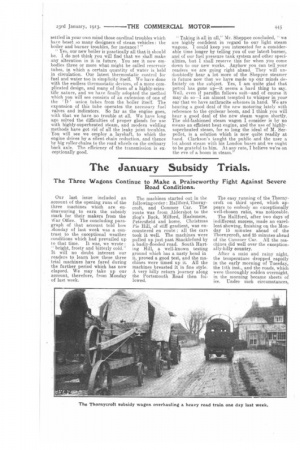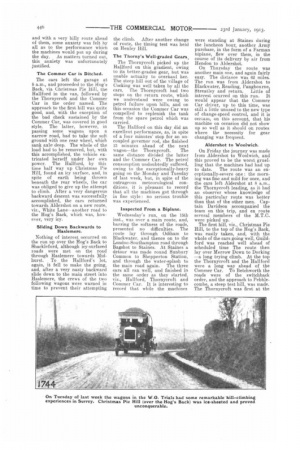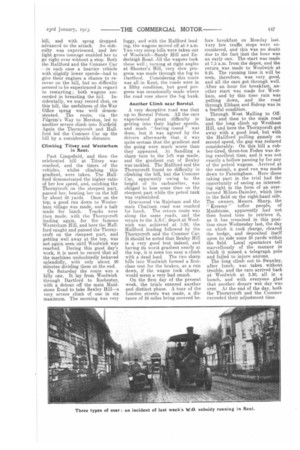The January Subsidy Trials.
Page 5

Page 6

Page 7

If you've noticed an error in this article please click here to report it so we can fix it.
The Three Wagons Continue to Make a Praiseworthy Fight Against Severe Road Conditions.
Our last issue included an account of the opening runs of the three machines which are endeavouring to earn the subsidy Mark for their makers from the War Office. The concluding paragraph of that account told how alonday of last week was a contrast to the exceptional weather conditions which had prevailed up to that time. It was, we wrote : " bright, frosty and bitterly cold." It will no doubt interest our readers to learn how these three trial machines have fared during the further period which has now elapsed. We may take up our account, therefore, from Monday of last week.
The machines started out in the following order : Hallford, Thornycroft, and Commer Car. The route was from Aldershot to the Hog's Pack, Milford, Haslemere, Petersfield and home_ Christmas Pie Hill, of stiff gradient, was encountered en route ; all the cars took it well. The machines were pulled up just past Shackleford by a badly-flooded road. South Harting Hill, a well-known testing ground which has a nasty bend in it, proved a good test, and the machines were timed up it. All the machines breasted it in fine style. A very hilly return journey along the Portsmouth Road then followed.
The easy running of the Thornycroft on third speed, which appears to embody an exceptionally well-chosen ratio, was noticeable.
The Hallford, after two days of indifferent success, made an excellent showing, finishing on the Monday 15 minutes ahead of the Thornycroft, and 25 minutes ahead of the Commer Car. All the machines did well over the exceptionally-hilly country.
After a mild and rainy night, the temperature dropped rapidly in the early morning of Tuesday, the 14th inst. and the roads, which were thoroug:hly sodden overnight, in the morning became sheets of ice. Under such circumstances, and with a very hilly route ahead of them, some anxiety was felt by all as to the performance which the machines would put up during the day. As matters turned out, this anxiety was unfortunately justified.
The Commer Car is Ditched.
The cars left the garage at 8 a.m., and proceeded to the Hog's Back, via Christmas Pie Hill, the Hanford in the van, followed by the Thornycroft and the Commer Car in the order named. The approach to the first, hill was quite good, and, with the exception of the bad check sustained by the Commer Car, was covered in good style. The latter, however, in passing some wagons upon a narrow road, had to take the soft ground with one rear wheel, which sank axle deep. The whole of the load had to be removed, but, with this accomplished, the vehicle extricated herself under her own power. The Hanford, by this time half way up Christmas Pie Hill, found an icy surface, and, in spite of earth being ,thrown beneath the rear wheels, the car was obliged to give up the attempt to climb. After a very dangerous backward descent was successfully accomplished, the cars returned towards 'Aldershot on a new route, viz., White Laneanother road to the Hog's Back, which was, however, very icy.
Sliding Down Backwards to Haslemere.
Nothing of interest occurred on the run up over the Hog's Back to Shackleford, although icy-surfaced roads were met on the road through Haslemere towards Midhurst. To the Hallford's lot, again, it fell to make the going, and, after a very nasty backward slide down to the main street into Haslemere, the crews of the two following wagons were warned in time to prevent their attempting the climb. After another change of route, the timing test was held on Henley Bill.
The Thorny's Well-graded Gears.
The Thornycroft picked up the HaIlford on this gradient, owing to its better-gradeu gear, but was unable actually to overhaul her. The steep hill out of the village of Cocking was well taken by all the cars. The Thornycroft had two stops on the return route, which we understand were owing to petrol failure upon hills, and on this occasion the Commer Car was compelled to replenish the tank from the spare petrol which was carried.
The Hanford on this day did an. excellent performance, as, in spite of a four minutes' stop for an uncoupled governor rod, she finished 13 minutes ahead of the next wagon—the Thornycroft. The same distance divided the latter and the Commer Car. The petrol consumption undoubtedly suffered, owing to the exceptionally-heavy going on the Monday and Tuesday of last week, but, in spite of the outrageous meteorological conditions, it is pleasant to record that all the machines got through in fine style : no serious trouble was experienced.
Inspected From a Biplane.
Wednesday's run, on the 15th inst., was over a main route, and, barring the softness of the roads, presented no difficulties. The route lay through Odiham to Blackwater, and thence on to the London-Southampton road through Bagshot to Staines. At Staines a detour was made round Sunbury Common to Shepperton Station, and through the water-splash to the main road again. The three cars all ran well, and finished in the same order as they started, viz., Hanford, Thornycroft and Commer Car. It is interesting to record that while the machines were standing at Staines during the luncheon hour, another Army purchase, in the form of a Farman biplane, Hew over them, in the course of its delivery by air from Hendon to Aldershot.
On Thursday the route was another main one, and again fairly easy. The distance was 62 miles. The run was from Aldershot to Blackwater, Reading, Pangbourne,
Streatley and return. Little of interest ocurred on this run. It would appear that the Commer Car driver, up to this time, was still a little unused to the new type of change-speed control, and it is certain, on this account, that his machine on occasion did not show up so well as it should on routes where the necessity for gear changing was frequent.
Aldershot to Woolwich.
On Friday the journey was made from Aldershot to Woolwich, and this proved to be the worst gruelling that the machines had had up to date. The route was an exceptionally-severe one : the morning was fine and mild for once, and the cars left Aldershot at 8 the Thornycroft leading, as it had an observer whose knowledge of this particular route was better than that of the other men. Captain Davidson accompanied the team on this trip, and en route several members of the M.T.C. were picked up.
The first hill, viz., Christmas Pie Hill, to the top of the Hog's Back, was easily taken, and, with the whole of the cars going well, Guildford was reached well ahead of scheduled time The route then lay over Iderrow Down to Dorking —a long trying climb. At the top the Thornycroft and the Hanford were a long way ahead of the Cornraer Car. To Betchworth the roads were of the switchback order, and the approach to Pebblecombe, a steep test hill, was made. The Thornycroft was first at the
hill, and with sprag dropped advanced to the attack. .No anticulty was experienced, and her light gross tonnage enabled her to go right over without a stop. Both the Hanford and the Commer Car --in each case a heavier vehicle with slightly lower speeds—had to give their engines a chance to recover on the hill, but no difficulty seemed to be experienced in regard to restarting ; both wagons succeeded in breasting the hill. Incidentally, we may record that, on this hill, the usefulness of the War Office sprag was well demonstrated. The route, via the Pilgrim's Way to Merston, led to another severe climb into .Nutfield. Again the Thornycroft and Hanford led the Commer Car up the hill by a considerable distance.
Climbing Tasty and Westerham in Kent.
Past Limpsfield, and then the celebrated hill at Titsey was reached, and the times of the vehicles, whilst climbing this gradient, were taken. The Hanford demonstrated the higher ratio of her low speed, and, catching the Thornycroft on the steepest part, passed her, beating her on the hill by about 60 yards. Once on the top, a good run down to Westerham village was made, and a halt made for lunch. Tracks were then made, with the Thornycroft leading again, for the famous Westerba.m Hill, and here the Hallford caught and passed the Thornycroft on the steepest part, and getting well away at the top, was not again seen until Woolwich was reached. During this good day's work, it is meet to record that all the machines undoubtedly behaved splendidly, with only about 20 minutes dividing them at the end. On Saturday the route was a hilly one. It lay from Woolwich through Dartford to Rochester, with a detour off the main Maidstone Road to take Bexley Hill—a very severe climb of one in six maximum. The morning was very foggy, and with the Hallford leading, the wagons moved off at 8 a.m. Two very steep hills were taken out of Woolwich—Sandy Hill and Enderleigh Road. All the wagons took these well ; turning at right angles at Shooter's Hill, very slow progress was made through the fog to Dartford. Considering this noute was all in Kent, the roads were M a filthy condition, but good progress was occasionally made where the road rose above the fog bank.
Another Climb near Borstal.
A very deceptive road was that up to Borstal _Prison. All the cars experienced great difficulty in getting into their higher speeds, and much "feeling round " was done, but it was agreed by the drivers afterwards that it was quite certain that the gradient and the going were much worse than they appeared. At Sandling a sharp turn to the left was made, and the gradient out of Bexley was tackled. The Hanford and the Thornycroft found no difficulty in climbing the bill, but the Commer Car, apparently owing to the height of its carburetter, was obliged to lose some time on the steepest part while the petrol tank was replenished.
Gravesend via Rainham and the main Ch.athann road was reached For lunch. The return route was along the same roads, and the return to the A.S.C. depot at Woolwich was achieved at 3-30, the Hanford leading followed by the Thornycroft and the Commer Car. It should be noted that Bexley Hill is a very good test indeed, and having its worst gradient nearly at the top, it is none too easy a climb with a dead load. The two sharp hills into -Woolwich formed a firstclass test for the brakes, as a run down, if the wagon took charge, would mean a very bad smash.
On the first day of the present week, the trials entered another and distinct phase. A tour of the London streets was made, a distance of 28 miles being covered be fore breakfast on Monday last. Very few traffic stops were encountered, and this was no doubt due to the fact that the hour was an early one. The start was made at 7.5 a.m. from the depot, and the return was made to Woolwich at 9.25. The running time it will be seen, therefore, was very good, and all the cars got through well. After an hour for breakfast, another start was made for Wrotham, and by this time rain was pelting down, and the road through Eltham and Sidcup was in a fearful condition.
Through West Mailing to Offham, and then to the main road and the long climb up Wrotham Rill, and here the Thornycroft got away with a good lead, but with the Hanford pulling gamely on second speed, the gap was reduced considerably. On this hill a rubber-tired, three-ton Foden was doing excellent time, and it was not exactly a hollow passing by for any of the petrol wagons. Arrived at the summit, a good run was made down to Farningliam. Here those taking part in the trial had the opportunity of seeing an interesting sight in the form of an overturned Milnes-Daimler, which lies in the field on the right-hand side. The owners, Messrs. Sharp, the " Kreemy " toffee people, of Maidstone, apparently had not then found time to retrieve it, as it has remained in this position since Wednesday last, the day on which it took charge cleared the hedge, and deposited itself upon its side some 20 yards within the field. Local spectators tell marvellously of the manner in which it missed a telegraph pole and failed to injure anyone.
The long climb out to Swa.nley, after lunch, was taken without trouble, and the cars arrived back at Woolwich at 3.30, all in a bunch, and with everyone glad that another dreary wet day was over. At the end of the day, both the Thornycroft and the Commer exceeded their adjustment time.






















